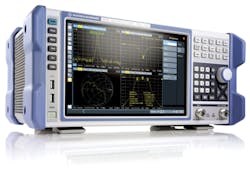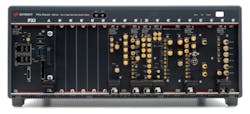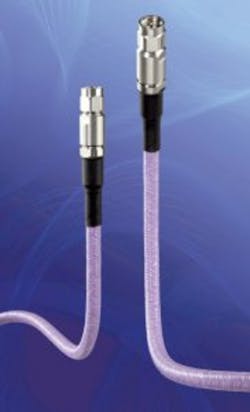The International Microwave Symposium in June in Honolulu has served as a fulcrum for RF/microwave innovation, with companies introducing new products—ranging from components to instruments and systems—and technologies preceding the show, during it, and after the event’s conclusion.
As described in our June issue,1 many companies planned to highlight products and technologies that had been introduced before IMS—for example, Analog Devices’ 1,000+ RF and microwave product portfolio; AR RF/Microwave Instrumentation’s amplifiers, hybrid RF power modules, and RF safety meters; MathWorks’ 5G Library for LTE System Toolbox; Pickering Interfaces’ 40-785B microwave multiplexer; Rigol’s EMC precompliance test capabilities; and Wireless Telecom Group’s Noisecom UFX7000A broadband noise generator and Boonton RTP5000 and RTP4000 real-time power sensors.
Other companies chose the show to introduce new products. Copper Mountain Technologies (CMT), for example, introduced 10 new products in its line of USB vector network analyzers, including the R180 1-port VNA (Figure 1), which features a frequency range from 1 MHz to 18 GHz and, the company says, is the first 18-GHz one-port VNA that can connect directly to DUT, improving measurement accuracy by eliminating the practical limitation of test cables. R180 can be controlled and powered through a USB-C port or through an external 5-VDC power supply.
Courtesy of Copper Mountain Technologies
CMT also expanded its Cobalt VNA product line. New two- and four-port models in 9-GHz and 20-GHz ranges offer direct receiver access that meets the needs of power-amplifier manufacturing test. Other new two- and four-port models in the 9-GHz and 20-GHz range will support frequency extension to 50 to 75 GHz, 60 to 90 GHz, and 75 to 110 GHz for 5G, IoT, automotive-radar test, and other applications.
CMT is not the only company making USB VNAs now. In April, Tektronix entered the market with its 6-GHz two-port, two path TTR500 model, and just before IMS, Pico Technology announced the PicoVNA 106, a 300-kHz to 6-GHz USB vector network analyzer.2
In an email interview,3 Alex Goloschokin, CMT’s founder and chief revenue officer, made the case for USB vector network analyzers and positioned his company in the newly competitive market. “Compared to other test instruments such as oscilloscopes and spectrum analyzers, VNAs typically are more demanding and complex,” he said. “Overall, customers are looking for smaller and less expensive VNA solutions but are not willing to compromise on feature set and performance.”
He made the case for USB instruments. “In any analyzer, including the VNA, the location of the processing module (a.k.a. computer) is not relevant to its performance,” he said. “A VNA’s performance is driven by many other factors, but not whether the computer is housed in the same location as the measurement module.” Consequently, he added, USB VNAs can perform as well as conventional VNAs and offer other advantages: the computer can be upgraded or repaired without affecting the instrument, an engineering department can afford more lower cost VNAs, and the instruments are portable, for example.
As for the competitive landscape, he said, “CMT has spent more than 10 years working on the metrological aspects of its VNA solutions to meet users’ high expectations, keeping instrument performance a priority. The company has a dedicated metrology group that focuses on measurement accuracy and stability during the design phase of the instruments and closely monitors production in order to guarantee that solutions perform within the specified uncertainty limits.”
More instruments at IMS
Signal generators also received attention at IMS. For example, Keysight Technologies announced the M9383A scalable PXIe microwave signal generator (Figure 2) with frequency coverage to 44 GHz and modulation bandwidth up to 1 GHz for generating complex waveforms used in emerging 5G and aerospace and defense applications. The company said the M9383A delivers 1% EVM, a critical measure of 5G modulated signal performance, for 800-MHz-wide pre-5G waveforms.
Courtesy of Keysight Technologies
The company also said engineers can create Keysight-validated Verizon pre-5G standard (5GTF) compliant waveforms and 5G candidate waveforms, such as 8×100-MHz OFDM component carriers, for the PXIe signal generator using Keysight’s Signal Studio or SystemVue software. The software also allows engineers to create custom waveforms for emerging wireless, 5G New Radio, and aerospace and defense applications.
National Instruments addressed the combination of analyzers and generators with an emphasis on its vector signal transceiver (VST) technology at IMS. The company announced a baseband model with 1 GHz of complex I/Q bandwidth. The PXIe-5820 combines a wideband I/Q digitizer, wideband I/Q arbitrary waveform generator, and high-performance user-programmable FPGA into a single two-slot PXI Express module. The baseband VST suits a range of applications including 5G, 802.11ax, and LTE-Advanced Pro.
NI also offered a pre-5G waveform generation and measurement technology demonstration, featuring signal generation and analysis of waveforms representative of both the Verizon 5G Technical Forum (5GTF) and 3GPP’s proposed New Radio (NR) physical layers. The technology demonstration combines the 1-GHz bandwidth of the PXIe-5840 second-generation VST with pre-5G software for waveform modulation and demodulation.
Eastern OptX announced the Model 1200 low-loss ground-to-antenna tower top system. The company noted that cable connections often are found in radar-test, cellular, and other communication systems—presenting problems due to cable loss and consequent reduction of the signal-to-noise ratio. The Model 1200 reduces the transmission loss associated with RF cable links used in antenna-tower connections (up to 40 GHz).
Noise XT introduced the PNG-A phase-noise generator, a 2-lb instrument costing less than $3,000. The company said the PNG-A is the first signal source to deliver a signal with mathematically computed phase noise in real time. “There is no test industry standard for phase noise calibration,” said Guillaume De Giovanni, president, Noise XT, in a press release. “This is a new type of instrument in the phase noise industry; no one has ever released such a universal solution.” De Giovanni continued, “As circuits become more complex, they cannot tolerate the slightest noise. Accurate detection and depiction of phase noise are critical for rapid 5G development.”
In other news, Remcom chose IMS to highlight a partnership with P3 group to provide a comprehensive solution for test and measurement combined with EM modeling and simulation. The partnership further extends the successful collaboration in air cabin communications modeling that commenced between Remcom and P3 aero systems in late 2016, giving P3’s customers access to Remcom’s electromagnetic simulation and propagation prediction software to augment test and measurement efforts.
Materials and components
Also at IMS, W. L. Gore & Associates highlighted its new PHASEFLEX microwave/RF test assemblies, Type 0N, for high-density test/interconnection, which offers consistent, repeatable measurements with stable electrical performance up to 50 GHz (Figure 3). Gore also said it has expanded the functional frequency range of its FF Series GORE VNA Microwave/RF Test Assemblies, now offering stable, reliable performance up to 70 GHz.
Courtesy of W. L. Gore & Associates
In IMS component news, Peregrine Semiconductor highlighted the UltraCMOS PE42823, a high-power receiver-protection RF switch. Suitable for wireless infrastructure applications, this reflective switch is optimized for emerging MIMO radio architectures. The company said the PE42823 delivers excellent single-event peak-power handling, low power consumption, and high linearity. Offered in a compact form factor, this high-power switch features built-in ESD protection.
Anokiwave announced the expansion of its family of Ka-band 5G ICs with the worldwide release of what it called the first commercially available 39-GHz silicon active-antenna quad-core ICs for 5G communications markets. The AWMF-0123/5 ICs operate from 37.1 to 40 GHz, support four radiating elements, and include 5-bit phase control and 5-bit gain control for analog RF beam steering.
In addition, Diamond Microwave, a specialist in microwave power-amplifier modules, announced the streamlining of its range of compact microwave GaN-based pulsed solid-state power amplifiers (SSPA) onto two common platforms, along with the introduction of new X-band PA models. The company described its flagship DM-X400-02 as a smart X-band SSPA that offers power levels in excess of 400-W over a 1,600-MHz bandwidth—and approaching 500 W over 750 MHz—with pulse widths up to 100 µs and duty cycles up to 15%.
And in passive-component news, AVX showcased its portfolio of RF and microwave solutions. The company introduced products including high-power resistors, attenuators, terminations, and capacitors; wire-bond resistors; and low-pass, band-pass, and high-pass thin-film and multilayer organic (MLO) filters. Frequency capabilities for the portfolio extend from the kilohertz range to 100 GHz, and power capabilities extend up to hundreds of watts, enabling employment in a variety of commercial, consumer, automotive, industrial, medical, telecommunications, optical, space, and military applications with environmental conditions ranging from harsh to benign, the company said.
Innovation continues
After the show, Rohde & Schwarz launched the benchtop R&S ZNLE vector network analyzer (Figure 4) to address the requirements of customers looking to perform RF measurements to characterize components such as antennas, attenuators, filters, and PCBs. The new standalone instrument weighs 6 kg and has a footprint of 408 mm x 235 mm, saving up to two-thirds of space on the workbench compared with competitive VNAs, the company said. The two-port vector network analyzer provides quick and accurate measurements due to its easy-to-use S-parameter wizard. The R&S ZNLE performs bidirectional measurements of the S11, S21, S12, and S22 S-parameters. The instrument comes in two models with frequency ranges from 1 MHz to 3 GHz (R&S ZNLE3) and to 6 GHz (R&S ZNLE6).
Courtesy of Rohde & Schwarz
In addition, Anritsu has introduced a single-instrument solution that enables 1-Gb/s IP data communications throughput testing based on its MD8475B signaling tester (Figure 5) that supports 4×4 MIMO with 256QAM high-order modulation and four-component carrier aggregation. The integrated system, which consists of the new MD8475B-071 enhanced multisignaling unit option and LTE 4×4 MIMO software, lowers cost-of-test and improves time-to-market by simplifying mobile device evaluation for device makers, chipset manufacturers, and mobile operators, the company said.
Courtesy of Anritsu
Also since the conclusion of IMS, NI announced multiple-antenna user-equipment (UE) support for its LabVIEW Communications MIMO Application Framework. Wireless researchers can pair the MIMO Application Framework with NI software-defined-radio hardware to conduct real-time, over-the-air experiments for a wide range of MIMO research topics including multi-user MIMO, single-user MIMO, and massive MIMO. This multi-FPGA physical layer reference design ships with well-documented LabVIEW Communications source code that is fully reconfigurable and modifiable.
“Massive MIMO has emerged as one of the leading 5G technologies that has the potential to provide unprecedented levels of spectral efficiency that will be critical in supporting the vast number of wireless devices expected to come online in the coming years,” said Fredrik Tufvesson, IEEE fellow and professor of radio systems at Lund University, in a press release. “NI’s MIMO Application Framework provides the hardware and software capabilities needed so that beamforming techniques can be explored at not just the massive MIMO base station, but also at the multi-antenna UEs to further enhance the overall system performance of 5G networks.”
IMS organizers reported a stellar year for the 2017 technical program, with 1,081 submitted and 554 presented technical papers—the second highest in the 60-year history of IMS. International attendees representing 50 countries made up 44% percent of technical participants, with technical attendance standing at 2,500. The exhibit featured 450 companies.
The emphasis on 5G before, during, and after the event indicates the importance of the trends driving 5G development. Yet another trend emerging from IMS 2017, said Goloschokin of CMT, is the imminent move of many IoT technologies from research to commercialization, which he said will “… drive the demand for lower cost instrumentation over the next five to 10 years. With the market moving IoT products from research to commercialization, customer requirements for reliability are increasing, along with demand for smaller, lower cost, and more automated instruments.”
Goloschokin said VNAs also are finding use in materials testing, with compact USB VNAs able to be incorporated into test systems due to their size and portability. “A number of attendees at IMS were very interested in an airplane canopy testing system demonstrated at CMT’s stand by Compass Technologies, which incorporated one of CMT VNAs,”
he said.
You can expect innovation to continue at a furious pace in the months leading up to IMS 2018, which will be held June 10-15 in Philadelphia. In the nearer term, you can expect many IMS exhibitors to reprise their IMS demonstrations and introduce new products and technologies at EDI CON USA, scheduled for Sept. 11-13 in Boston.
References
- Earls, A., “WLAN, radar, IoT, V2X to complement 5G at IMS,” EE-Evaluation Engineering, June 2017, p. 8.
- Nelson, R., “Portable units sport impressive GUIs, or lack them altogether,” EE-Evaluation Engineering, August 2017, p. 28.
- Nelson, R., “CMT founder makes the case for USB vector network analyzers,” Rick’s Blog, EE-Evaluation Engineering, July 27, 2017.
For more information
- Analog Devices
- Anokiwave
- Anritsu
- AR RF/Microwave Instrumentation
- AVX
Copper Mountain Technologies - Diamond Microwave
- Eastern OptX
- Keysight Technologies
- MathWorks
- National Instruments
- Noise XT
- Peregrine Semiconductor
- Pickering Interfaces
- Pico Technology
- Rigol
- Rohde & Schwarz
- Tektronix
- W.L. Gore
- Wireless Telecom Group
About the Author

Rick Nelson
Contributing Editor
Rick is currently Contributing Technical Editor. He was Executive Editor for EE in 2011-2018. Previously he served on several publications, including EDN and Vision Systems Design, and has received awards for signed editorials from the American Society of Business Publication Editors. He began as a design engineer at General Electric and Litton Industries and earned a BSEE degree from Penn State.





